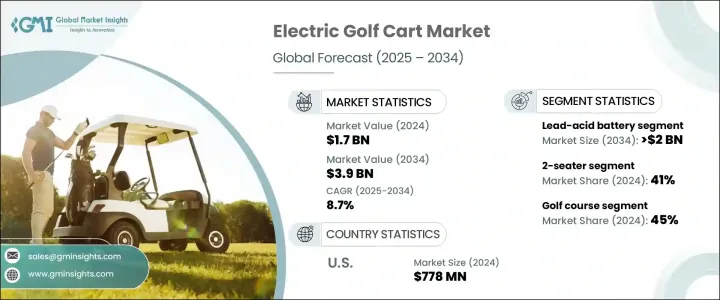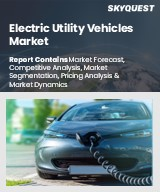
|
시장보고서
상품코드
1721498
전동 골프 카트 시장 기회, 성장 촉진요인, 산업 동향 분석 및 예측(2025-2034년)Electric Golf Cart Market Opportunity, Growth Drivers, Industry Trend Analysis, and Forecast 2025 - 2034 |
||||||
세계의 전동 골프 카트 시장은 2024년에는 17억 달러로 평가되었고, CAGR 8.7%를 나타내 2034년에는 39억 달러에 이를 것으로 추정되고 있습니다. 그 환경 친화적인 매력, 최소한의 소음 출력, 낮은 운용 코스트는 폭넓은 유저를 매료해 계속하고 있습니다.

제로 방출 이동성에 대한 선호도가 높아짐에 따라 충전 인프라 발전, 정부 우대 조치 및 환경 친화적인 통근 수단으로의 문화적 이동으로 더욱 향상되고 있습니다. 뿐만 아니라 단거리 이동 요구에 보다 깨끗하고 조용하며 경제적인 이동 수단을 제공합니다.
| 시장 범위 | |
|---|---|
| 시작 연도 | 2024년 |
| 예측 연도 | 2025-2034년 |
| 시작 금액 | 17억 달러 |
| 예측 금액 | 39억 달러 |
| CAGR | 8.7% |
배터리 유형별로는 납 배터리, 리튬 이온 배터리 등이 있으며, 2024년 시장 점유율은 납 배터리가 60%를 차지했습니다. 리튬 이온 배터리가 경량으로 라이프 사이클이 긴 것으로부터 지지를 모으게 되어도, 납 축전지 시스템의 폭넓은 입수성과 실증이 끝난 내구성에 의해 상용에서도 개인에서도 납 축전지가 리드를 유지하고 있습니다.
좌석 수에 따라 시장은 2인승, 4인승, 6인승, 기타로 구분됩니다. 저감을 의미해 주택지, 별장, 캠퍼스에서의 단거리 이동에 최적인 선택이 되고 있습니다. 특히, 신규 유저나 용량이나 추가 기능보다 효율성을 우선하는 레크리에이션 목적의 구입자에게 있어서는 저렴한 가격이 강력한 추진력이 되고 있습니다.
북미의 전동 골프 카트 시장은 56%의 점유율을 차지하고 미국은 2024년에 7억 7,800만 달러를 창출했습니다. 정부의 지원, 인프라 정비, 에코를 의식한 통근에 대한 일반 시민의 의식이, 전국의 주택, 상업시설, 지자체에서의 채용을 위한 강력한 조건을 만들어 내고 있습니다.
야마하, Club Car, Alke, EZ-GO, Autopower, HDK Electric Vehicle, Garia, Marshell Green Power, Suzhou Eagle Electric Vehicle Manufacturing, Guangdong Lvtong New Energy Electric Vehicle Technology와 같은 주요 기업들은 첨단 배터리 기술, 커넥티드 차량 기능, 커스터마이징 가능한 플랫폼으로 혁신을 추진하고 있으며, 이러한 기업들은 지속가능성을 중시한 소재를 채용하고, 전략적 파트너십을 구축하고, 임대 옵션을 확대하여, 상용 플릿과 개인 유저 모두의 진화하는 요구를 서포트하고 있습니다.
목차
제1장 조사 방법과 범위
제2장 주요 요약
제3장 업계 인사이트
- 생태계 분석
- 공급업체의 상황
- 원재료 공급업체
- 부품 제조업체
- OEM
- 유통업체
- 최종 용도
- 이익률 분석
- 기술 및 혁신 전망
- 특허 분석
- 주요 뉴스와 대처
- 규제 상황
- 영향요인
- 성장 촉진요인
- 게이트식 주택 커뮤니티 수요 증가
- 연료 구동 카트를 대체하는 친환경 대체품
- 리조트나 관광에서의 이용 확대
- 배터리 성능의 기술적 진보
- 업계의 잠재적 위험 및 과제
- 전기 모델의 초기 높은 비용
- 항속 거리 제한 및 배터리 수명 문제
- 성장 촉진요인
- 성장 가능성 분석
- Porter's Five Forces 분석
- PESTEL 분석
제4장 경쟁 구도
- 서론
- 기업 시장 점유율 분석
- 경쟁 포지셔닝 매트릭스
- 전략적 전망 매트릭스
제5장 시장 추계·예측 : 배터리별(2021-2034년)
- 주요 동향
- 납축 배터리
- 리튬 이온 배터리
- 기타
제6장 시장 추계·예측 : 좌석수별(2021-2034년)
- 주요 동향
- 2인승
- 4인승
- 6인승
- 기타
제7장 시장 추계·예측 : 용도별(2021-2034년)
- 주요 동향
- 골프 코스
- 개인/주택
- 상업 및 공업
제8장 시장 추계·예측 : 지역별(2021-2034년)
- 주요 동향
- 북미
- 미국
- 캐나다
- 유럽
- 영국
- 독일
- 프랑스
- 스페인
- 이탈리아
- 러시아
- 북유럽 국가
- 아시아태평양
- 중국
- 인도
- 일본
- 한국
- 호주 및 뉴질랜드
- 동남아시아
- 라틴아메리카
- 브라질
- 멕시코
- 아르헨티나
- 중동 및 아프리카
- 아랍에미리트(UAE)
- 남아프리카
- 사우디아라비아
제9장 기업 프로파일
- Alke
- Autopower
- Club Car
- Columbia Vehicle Group
- EZ-GO
- Garia
- Guangdong Lvtong New Energy Electric Vehicle Technology
- HDK Electric Vehicle
- ICON Electric Vehicles
- Italcar
- Marshell Green Power
- PowaKaddy
- Star EV
- Suzhou Eagle Electric Vehicle Manufacturing
- Yamaha
The Global Electric Golf Cart Market was valued at USD 1.7 billion in 2024 and is estimated to grow at a CAGR of 8.7% to reach USD 3.9 billion by 2034. This expansion reflects a larger trend in mobility preferences, with individuals and businesses increasingly leaning toward compact, energy-efficient transportation solutions. Electric golf carts, once limited to golf courses, have evolved into versatile mobility tools for residential, recreational, and commercial applications. Their eco-friendly appeal, minimal noise output, and low operational costs continue to attract a wide range of users. From gated communities and university campuses to resorts and industrial zones, the adoption of these low-speed electric vehicles is rising as urban planners, institutions, and private sectors push toward sustainable alternatives to traditional internal combustion vehicles.

The growing preference for zero-emission mobility is further supported by advancements in charging infrastructure, favorable government incentives, and a cultural shift toward greener commuting options. These vehicles are becoming an integral part of smart city projects and urban mobility systems, offering a cleaner, quieter, and more economical mode of travel for short-range transit needs. With their customizable features and evolving tech integrations, electric golf carts are also finding appeal among younger demographics and fleet operators looking for scalable, budget-friendly transport solutions.
| Market Scope | |
|---|---|
| Start Year | 2024 |
| Forecast Year | 2025-2034 |
| Start Value | $1.7 Billion |
| Forecast Value | $3.9 Billion |
| CAGR | 8.7% |
By battery type, the market includes lead-acid, lithium-ion, and others, with lead-acid batteries holding a 60% market share in 2024. This segment continues to dominate due to its cost-effectiveness and dependable performance history. Buyers in price-sensitive regions often choose lead-acid batteries for their lower upfront costs and compatibility with current servicing frameworks. Even as lithium-ion batteries gain traction for their lighter weight and longer life cycle, the extensive availability and proven durability of lead-acid power systems keep them in the lead for commercial and personal use alike.
Based on seating capacity, the market is segmented into 2-seater, 4-seater, 6-seater, and more. The 2-seater segment accounted for a 41% share in 2024, driven by demand for compact, easy-to-maneuver vehicles. Their lightweight structure means lower energy consumption and maintenance, making them a go-to choice for short-distance trips in residential areas, vacation communities, and campuses. The affordability factor remains a strong driver, particularly for new users and recreational buyers prioritizing efficiency over capacity or additional features.
North America Electric Golf Cart Market held a 56% share, with the US generating USD 778 million in 2024. Market growth is spurred by increasing urban acceptance of low-speed electric vehicles. Government support, infrastructure developments, and public awareness of eco-conscious commuting are creating strong conditions for adoption in residential, commercial, and municipal settings across the country.
Leading companies, including Yamaha, Club Car, Alke, EZ-GO, Autopower, HDK Electric Vehicle, Garia, Marshell Green Power, Suzhou Eagle Electric Vehicle Manufacturing, and Guangdong Lvtong New Energy Electric Vehicle Technology, are driving innovation with advanced battery technologies, connected vehicle features, and customizable platforms. These players are also embracing sustainability-focused materials, building strategic partnerships, and expanding leasing options to support the evolving needs of both commercial fleets and private users.
Table of Contents
Chapter 1 Methodology & Scope
- 1.1 Research design
- 1.1.1 Research approach
- 1.1.2 Data collection methods
- 1.2 Base estimates and calculations
- 1.2.1 Base year calculation
- 1.2.2 Key trends for market estimates
- 1.3 Forecast model
- 1.4 Primary research & validation
- 1.4.1 Primary sources
- 1.4.2 Data mining sources
- 1.5 Market definitions
Chapter 2 Executive Summary
- 2.1 Industry 360º synopsis, 2021 - 2034
Chapter 3 Industry Insights
- 3.1 Industry ecosystem analysis
- 3.2 Supplier landscape
- 3.2.1 Raw material suppliers
- 3.2.2 Component manufacturers
- 3.2.3 OEM
- 3.2.4 Distributors
- 3.2.5 End use
- 3.3 Profit margin analysis
- 3.4 Technology & innovation landscape
- 3.5 Patent analysis
- 3.6 Key news & initiatives
- 3.7 Regulatory landscape
- 3.8 Impact forces
- 3.8.1 Growth drivers
- 3.8.1.1 Rising demand in gated residential communities
- 3.8.1.2 Eco-friendly alternatives replacing fuel-powered carts
- 3.8.1.3 Expanding use in resorts and tourism
- 3.8.1.4 Technological advancements in battery performance
- 3.8.2 Industry pitfalls & challenges
- 3.8.2.1 High initial cost of electric models
- 3.8.2.2 Limited range and battery lifespan issues
- 3.8.1 Growth drivers
- 3.9 Growth potential analysis
- 3.10 Porter’s analysis
- 3.11 PESTEL analysis
Chapter 4 Competitive Landscape, 2024
- 4.1 Introduction
- 4.2 Company market share analysis
- 4.3 Competitive positioning matrix
- 4.4 Strategic outlook matrix
Chapter 5 Market Estimates & Forecast, By Battery, 2021 - 2034 ($Bn, Units)
- 5.1 Key trends
- 5.2 Lead-acid battery
- 5.3 Lithium-ion battery
- 5.4 Others
Chapter 6 Market Estimates & Forecast, By Seating Capacity, 2021 - 2034 ($Bn, Units)
- 6.1 Key trends
- 6.2 2-seater
- 6.3 4-seater
- 6.4 6-seater
- 6.5 Others
Chapter 7 Market Estimates & Forecast, By Application, 2021 - 2034 ($Bn, Units)
- 7.1 Key trends
- 7.2 Golf course
- 7.3 Personal/residential
- 7.4 Commercial & industrial
Chapter 8 Market Estimates & Forecast, By Region, 2021 - 2034 ($Bn, Units)
- 8.1 Key trends
- 8.2 North America
- 8.2.1 U.S.
- 8.2.2 Canada
- 8.3 Europe
- 8.3.1 UK
- 8.3.2 Germany
- 8.3.3 France
- 8.3.4 Spain
- 8.3.5 Italy
- 8.3.6 Russia
- 8.3.7 Nordics
- 8.4 Asia Pacific
- 8.4.1 China
- 8.4.2 India
- 8.4.3 Japan
- 8.4.4 South Korea
- 8.4.5 ANZ
- 8.4.6 Southeast Asia
- 8.5 Latin America
- 8.5.1 Brazil
- 8.5.2 Mexico
- 8.5.3 Argentina
- 8.6 MEA
- 8.6.1 UAE
- 8.6.2 South Africa
- 8.6.3 Saudi Arabia
Chapter 9 Company Profiles
- 9.1 Alke
- 9.2 Autopower
- 9.3 Club Car
- 9.4 Columbia Vehicle Group
- 9.5 EZ-GO
- 9.6 Garia
- 9.7 Guangdong Lvtong New Energy Electric Vehicle Technology
- 9.8 HDK Electric Vehicle
- 9.9 ICON Electric Vehicles
- 9.10 Italcar
- 9.11 Marshell Green Power
- 9.12 PowaKaddy
- 9.13 Star EV
- 9.14 Suzhou Eagle Electric Vehicle Manufacturing
- 9.15 Yamaha



















